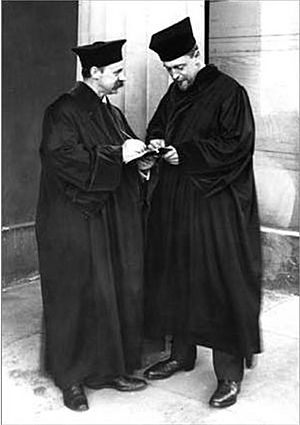Ejnar Hertzsprung facts for kids
Quick facts for kids
Ejnar Hertzsprung
|
|
|---|---|

Hertzsprung (right) and Karl Schwarzschild in front of the Göttingen Observatory building (1909)
|
|
| Born | 8 October 1873 |
| Died | 21 October 1967 (aged 94) |
| Alma mater | Copenhagen Polytechnic (DTU) |
| Known for | Hertzsprung gap Hertzsprung–Russell diagram |
| Spouse(s) | Henriette Mariette Augustine Albertine Kapteijn |
| Parents |
|
| Awards | Bruce Medal (1937) Gold Medal of RAS (1929) |
| Scientific career | |
| Fields | Chemistry, Astronomy |
| Institutions | Leiden Observatory |
Ejnar Hertzsprung (born in Copenhagen, Denmark, on October 8, 1873 – died October 21, 1967, in Roskilde) was a famous Danish chemist and astronomer. He made very important discoveries about stars.
Contents
Ejnar Hertzsprung's Life and Work
Ejnar Hertzsprung was born in Frederiksberg, Denmark. His father, Severin, and mother, Henriette, raised him. He first studied chemical engineering at Copenhagen Polytechnic Institute. He finished his studies in 1898.
After college, he worked as a chemist in Russia for two years. Then, in 1901, he studied photochemistry in Germany. This is the study of how light affects chemical reactions.
Discovering Star Secrets
Ejnar's father was an amateur astronomer. This sparked Ejnar's interest in space. In 1902, he started watching stars from Frederiksberg. He soon noticed something interesting about them.
He saw that stars with similar "spectral types" could have very different "absolute magnitudes." Spectral type tells us about a star's temperature and color. Absolute magnitude tells us how bright a star truly is.
In 1909, he began working at the Göttingen Observatory. He worked there with a famous scientist named Karl Schwarzschild.
The Hertzsprung–Russell Diagram
One of Ejnar Hertzsprung's biggest achievements was creating a special chart. This chart helps us understand stars better. He developed it in 1911. Another astronomer, Henry Norris Russell, created a similar chart in 1913.
This chart is now called the Hertzsprung–Russell diagram. It plots stars based on their brightness and temperature. It helps scientists classify stars. It also helps them understand how stars change over time.
Measuring Distances to Stars
In 1913, Hertzsprung found a way to measure distances to certain stars. These stars are called Cepheid variable stars. They get brighter and dimmer in a regular pattern.
He used a method called parallax to do this. Parallax is like how your thumb seems to move when you close one eye and then the other. He used this to figure out how far away these stars were.
This helped him confirm a discovery by Henrietta Swan Leavitt. She found a link between how fast a Cepheid star pulsed and its true brightness. Hertzsprung used this to estimate the distance to the Small Magellanic Cloud. This is a small galaxy near our own.
Work at Leiden Observatory
From 1919 to 1946, Hertzsprung worked at the Leiden Observatory in the Netherlands. He became the director there in 1937. One of his students was Gerard Kuiper, who also became a famous astronomer.
Hertzsprung's work helped us understand how stars are classified. It also showed us how stars develop over their lives. The Hertzsprung–Russell Diagram is still used today. It helps explain different types of stars and how they change.
Discovering Asteroids
Ejnar Hertzsprung also discovered two asteroids. Asteroids are small rocky objects that orbit the Sun. One of them is named 1627 Ivar. This asteroid is an Amor asteroid, which means its orbit is close to Earth's.
Ejnar Hertzsprung passed away in Roskilde in 1967. An asteroid, 1693 Hertzsprung, was named in his honor. There is also a crater on the Moon named after him.
Asteroids Discovered
- 1627 Ivar (discovered September 25, 1929)
- 1702 Kalahari (discovered July 7, 1924)
Honors and Awards
- Gold Medal of the Royal Astronomical Society in 1929
- Bruce Medal in 1937
- The lunar impact crater Hertzsprung
- The main-belt asteroid 1693 Hertzsprung
See also
 In Spanish: Ejnar Hertzsprung para niños
In Spanish: Ejnar Hertzsprung para niños

